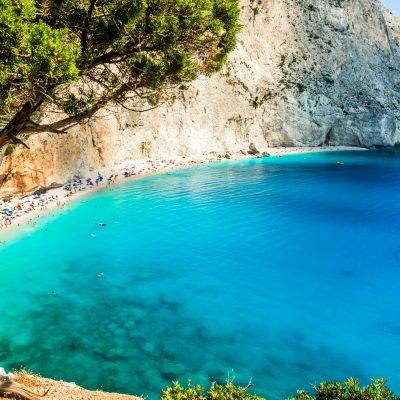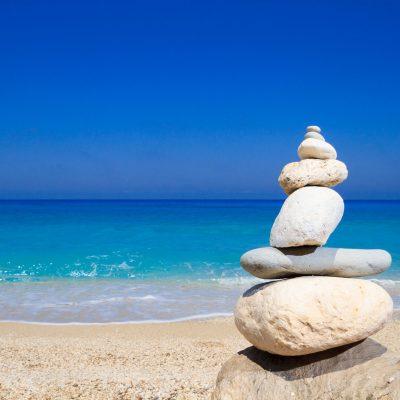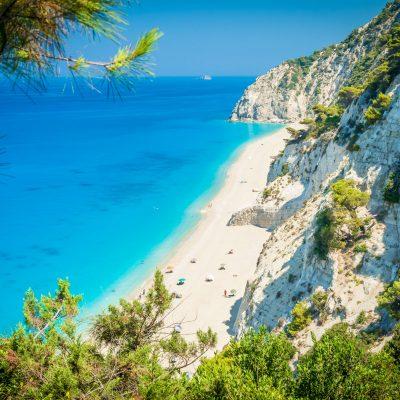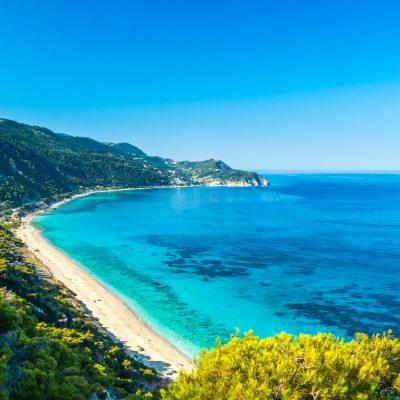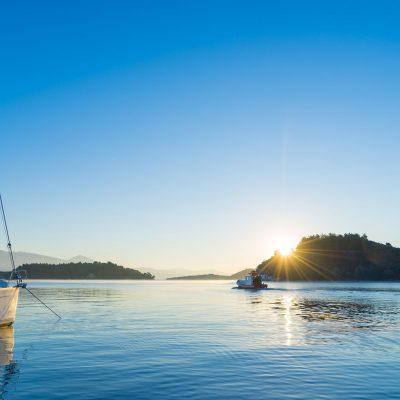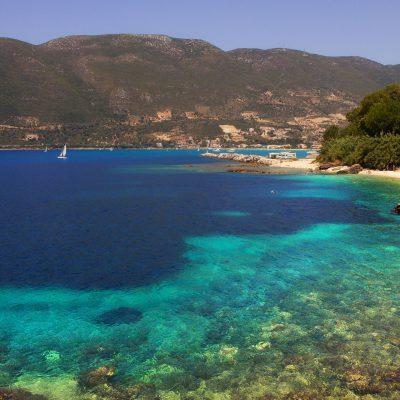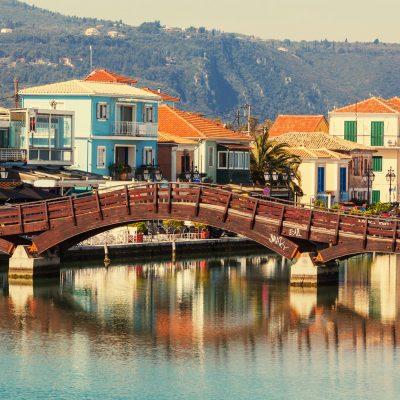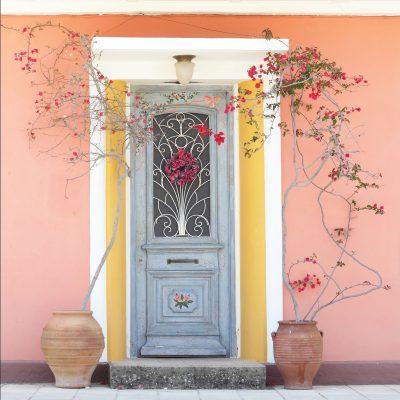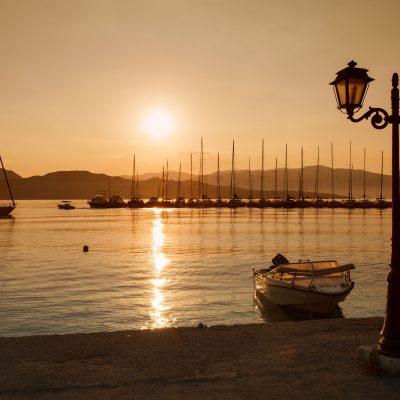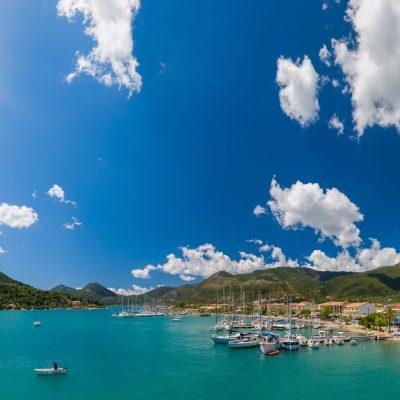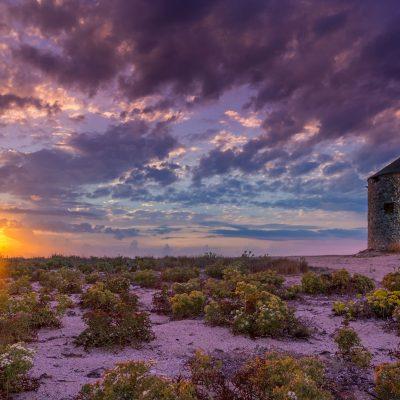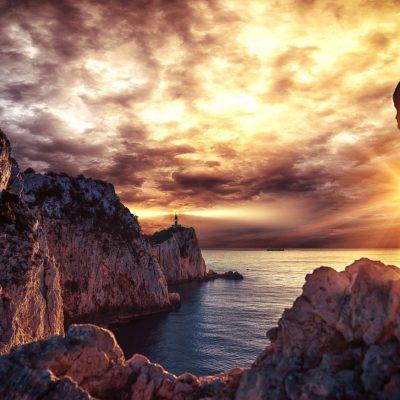Lefkada is an island of the Ionian Sea and belongs to the island complex of Eptanisa. It lies between the islands of Corfu and Kefalonia. It is very close to the shores of the western mainland of Greece. Only a small strip of sea separates the island from Akarnania and a fifty meter floating bridge connects them. Lefkada covers an area of 302.5 square kilometers and is the fourth in size Island in the Eptanese complex, with a population of 23.000 people. Lefkada along with the islands of Meganissi, Kalamos, Kastos, Scorpios, Skorpidi, Mathouri, Sparti, Thilia, Kythros and other smaller ones around them, constitutes the province of Lefkada with the city of Leukada as capital and is divided into 6 municipalities (Lefkada, Ellomenos, Apollonion, Karyas, Sfakioton and Meganissi) and two counties (Kalamos and Kastos).
The islands climate is Mediterranean, with long spells of sunshine all through the year, the temperate but rainy winter and the warm but pleasant summer due to the cooling breeze. The 70% of Lefkada is covered by mountains. The tallest top of all is Stavrota (1.182m) with Elati (1.126 μ.) following second and St Lias (1.014 m) and Mega Oros (1.012 m) come third and fourth.
On the west side of the island which is quite steep, there are many long sandy beaches. Lefkada possesses narrow plateaus, fertile valleys and canyons with rich plantation, while it also has a notable flora which includes olive trees, cypresses, a variety of pine trees, a special variety of oak, aromatic herbs and rare flowers. The island has many springs, like the known Kerasia springs in Sivros, torrents that become rather violent at times and form small cataracts like the one in Nydri, the Dimosaris and impressive canyons like the ones in Mellisa of Sfakiotes and in Haradiatikos. The two salt lakes in the northern part of the island are a very important reserve for many bird species.
Lefkada’s coastline is also very rich. It is comprised of impressive beaches, peninsulas, capes – the Lefkata Cape in particular – coves that make magnificent natural ports, distinguishing the ones of Vlihos, Syvota and Routha in the east and Vassiliki in the south side of the island. Many consecutive coves exist in Meganissi creating small but impressive fiords.
HISTORY OF LEFKADA
The name of the island “Lefkada” routed from the name “Lefkas Petra” or “Lefkas Akra”, an ancient name of today’s Leukata, the southern cape of the island. The wild white rocks of the cape where, according to, the poet Sapfo ended her life in the name of love, gave the name to the city, the Corinthians founded in Lefkada, and then to the entire island. According to geographer Stravonas they renamed the ancient city of Nirikos to Lefkada, capital of the island.
Humanity in Lefkada can be traced back to the Paleolithic era. The distinguished German archaeologist Wilhelm Dairepfeld, associate of Henry Schliemann in the Troy excavations, conducted extensive archaeological research in Nydri, and brought important findings from the copper age (2,000 B.C.) to light and hence started the theory that Lefkada can be identified with Homers Ithaca. The ancient city of Nirikos, 7th century b.c., which was discovered in Kalligoni at Koulmos, was the island’s first capital. It was surrounded by a great wall, of which only a small part is left.
The history of Lefkada, from the 7th century b.c. after becoming a Corinthian colony up until the Roman conquer, is politically connected to the city of Corinthos, which Lefkada followed in all important events of the time: the Salamina naval battle, the battle of Platees, the Peloponnesian war as an ally to the Spartans and the expedition of Alexander the Great. Strongly resisting to the Romans during the 3rd century B.C., Lefkada finally submits to the conqueror in the 2nd century. During the Roman occupation considerable projects were constructed, the stone bridge, to name one, which connected the island of Lefkada with Akarnania, and had a length of 700 meters. They also reconstructed the ancient wall.
In 1204 the island was incorporated to the dominion of Hepiros, but from the year 1294 Lefakada came into the hands of the French, since it was given as an offering to John, Count of Orsini, who later built the nucleus of the Aghia Mavra Castle, still erect today at the island’s entrance. The history of the island, since the 14th century and until it’s incorporation with the Greek state, is full of events – milestones of long historical adventure.
In 1331 Lefkada was conquered by the Andigavians, while in 1334 it becomes the feud of the Georgie. In 1357 the “Voukentra revolution”, the revolt of the islands farmers against the Gratian Georgie, arose, a fact that centuries later inspired the Lefkadite poet, Aristotelis Valaoritis, to write the famous work “Fotinos”. In 1362 the island was passed on to the hands of the Tokki and in 1479 was conquered by the Ottomans, only to fall temporarily, for two years (1502-3) in the hands of the Venetians and then again back to the Turks, for a prolonged period of time that ended in 1684.
The same year the Venetians return. Lefkada was occupied by Fransisco Morozini, the capital was transferred outside the castle, at the position it remains up untill now, called Amaxiki and the Lefkadites loose control of the port and commerce falls in the hands of the Venetians. The Venetian occupation is an especially difficult time for the Lefkadites, who were cut off from the rest of Greece and with the Venetians being indifferent in developing a cultural and social foundation, as they did in Zakynthos and Corfu, found it difficult to organize their social life and create their own cultural movement. However, during these years, the Venetians modernized public life by founding courts and setting the basis for organizing administrative services.
A period of continuous historic changes follows. The democratic French replace the Venetians in 1797 and immediately after that Lefkada as the rest of the Eptanisa falls under Russian – Turkish rule. From 1802 the island becomes a part of the Eptanesian State, the first semi independent Greek state, under Russian – Turkish protection.
In 1807 Lefkada is conquered by the imperial French only to fall in the hands of the British in 1810, who incorporate the island to United State of the Ionian Islands. Despite the bits of democratic freedoms provided, the English rule was on of cruelty and heavy taxing to the poor Lefkadites, a measure resulting in the revolt of the peasants. During that time, however, many public projects were constructed, such as roads, bridges and aqueducts.
The union of Lefkada as well as the rest of the Eptanisa to Greece happened in 1864 when, after Otto’s removal, came George the 1st to the throne. For a few years the civil class prospered and commerce especially developed. However in the beginning of the 20th century, the year 1900, peronospora a plants disease, destroyed all the islands vineyards, sending into poverty and despair the inhabitants. Then begun the great emigration to America and Canada, which lessened only after the end of the great wars of the century, where life in Lefkada improved significantly in the beginning of the sixties.
CULTURE
Lefkada is an island with a wide spiritual tradition. Its geographical position – like all the others islands of Ionian Sea – obtained a closer relationship with the West, in the years where all Continental Greece had been experiencing the spiritual Middle Age of Turkish Domination.
The temperamental Heptanisian culture and the unique feature of the island, full of “breath of the sea, breath of the pine trees” gave to Lefkada the opportunity to give birth and nurture some of the most sensitive poetic souls. In this island, were born or were springs, eminent artists and scientists with Pan-Hellenic recognition and international appreciation and publicity.
The manners, the customs and the creative speech of Lefkaditians, in different forms, the wishes and curses, the fairy tales and puzzles, the satirical songs and the humorous narratives, are composing the treasures of a rich and great tradition preserved alive until our days.
Many customs were created from the church calendar and the cycle of life – Christmas, Easter, Carnival and Lent. The most interesting are:
The music preferences of island’s different areas reflect its cultural lack of homogeneity. The villages are fond of folklore music and rebetika – a result from their relationship with Roumeli. The main town prefers chorus and mandolin music – a result from their relationship with Italy, since, during the Venetian domination and until the union of Greece, the children of the rich families were studying medicine or law in Italy, bringing back with them the culture and the values of West.
From the other side Venetians were promoting their culture all over Heptanisa, the result of today’s great influence in music and education. Lefkada has the oldest Philarmonic of Greece (1850). Its active Union contributed to the music and education development of Lefkadites and was present to great historical events, as the Union of Heptanisa in 1864, the first Olympic Games of Athens in 1896, the Intercalated Games of 1906 etc. In 1983, was awarded with the Academy of Athens prize. The Philarmonic offers a Music School, a Band, a Bandina and the Music Groups. Lefkada also has groups of traditional dance, chorus, mandolin orchestra with Pan Hellenic and international recognition.


